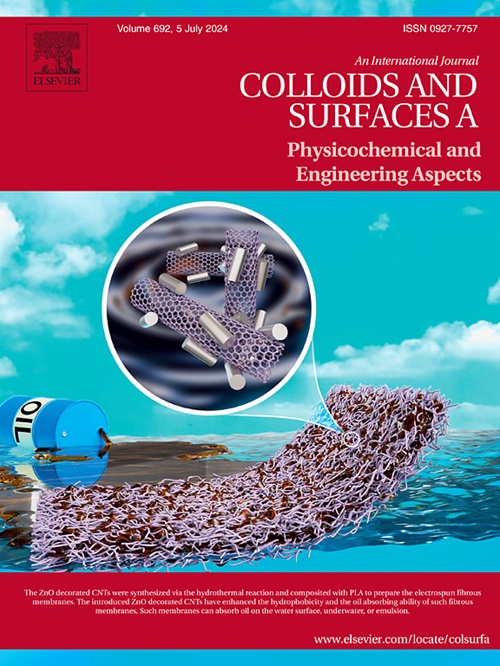两性共聚物纳米球与甜菜碱表面活性剂复合体系的提高采收率应用
IF 4.9
2区 化学
Q2 CHEMISTRY, PHYSICAL
Colloids and Surfaces A: Physicochemical and Engineering Aspects
Pub Date : 2025-04-18
DOI:10.1016/j.colsurfa.2025.136933
引用次数: 0
摘要
纳米材料与表面活性剂的结合是提高表面活性剂驱采收率的重要方法之一。针对海上某高温低渗油田(温度90 ℃,渗透率100 mD)的条件,以甲基丙烯酸、苯乙烯和阳离子苯胺为单体,通过乳液聚合法制备了新型两性共聚物(PMSN)纳米球。为了提高采收率,对共聚物单体的组成和甜菜碱的类型进行了优化,提出了一种新型的PMSN纳米球与椰酰胺丙基甜菜碱(CAB)复合驱油体系。驱油实验结果表明,当PMSN纳米球与CAB的质量比为1:2,总浓度为3000 mg/L时,采收率提高26.69 %,比3000 mg/L CAB提高5.66 %。驱油机理研究表明,PMSN纳米球可与CAB协同作用,进一步降低油水界面张力,改变岩心表面润湿性,从而有效降低原油在岩心表面的粘附功,提高CAB的驱油效率。本文章由计算机程序翻译,如有差异,请以英文原文为准。
A composite system of amphoteric copolymer nanosphere and betaine surfactant for enhanced oil recovery application
The combination of nanomaterial and surfactant is one of the important methods to enhance the oil recovery of surfactant flooding. In view of the conditions of a high-temperature and low-permeability offshore oilfield (temperature 90 °C, gas permeability 100 mD), a novel amphoteric copolymer (PMSN) nanosphere was prepared through emulsion polymerization by using methacrylic acid, styrene and cationic phenylamine monomer as the monomers. In aim to enhance oil recovery, the composition of copolymer monomers and betaine type were optimized, and a new composite oil displacement system of PMSN nanosphere and cocoamidopropyl betaine (CAB) was proposed in this work. The oil displacement experiment results showed that when the mass ratio of PMSN nanosphere to CAB was 1:2 and the total concentration was 3000 mg/L, the enhanced oil recovery was by 26.69 %, which was 5.66 % higher than that of 3000 mg/L CAB. The study of oil displacement mechanism showed that PMSN nanosphere can cooperate with CAB to further reduce the O/W interfacial tension and change the wettability of the core surface, thereby effectively reducing the adhesion work of crude oil on the core surface and improving the oil displacement efficiency of CAB.
求助全文
通过发布文献求助,成功后即可免费获取论文全文。
去求助
来源期刊
CiteScore
8.70
自引率
9.60%
发文量
2421
审稿时长
56 days
期刊介绍:
Colloids and Surfaces A: Physicochemical and Engineering Aspects is an international journal devoted to the science underlying applications of colloids and interfacial phenomena.
The journal aims at publishing high quality research papers featuring new materials or new insights into the role of colloid and interface science in (for example) food, energy, minerals processing, pharmaceuticals or the environment.

 求助内容:
求助内容: 应助结果提醒方式:
应助结果提醒方式:


